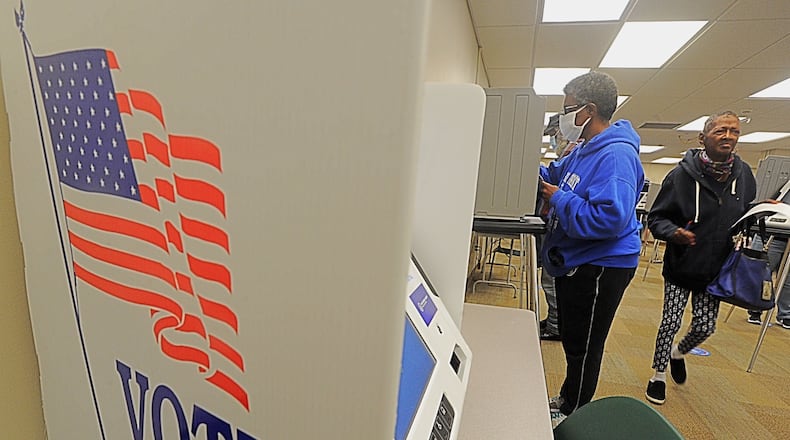“Barring any action from the General Assembly or action by the court, Secretary LaRose is prepared to move forward with a May 3 primary that includes candidates for statewide, congressional, and local offices, as well as local ballot issues, such as school levies,” a news release from LaRose’s office says. “As usual, Ohio voters can expect a secure, accessible, and accurate election.”
The Ohio Supreme Court has three times overturned new state legislative district maps approved by the Ohio Redistricting Commission. The court determined that those maps, which passed without support from the two Democrats on the seven-member commission, all unfairly favored Republicans.
The court set a deadline of March 28 for the commission to produce a fourth set of maps, and the commission is meeting daily this week — this time with assistance from independent map-drawing experts and federal court mediators. But any plan produced at this point, even if it faced no legal challenges, would likely be too late to use on May 3.
Those hired map-drawers were at work Thursday with Democratic and Republican staff, with their negotiations made public for the first time and streamed live on the Ohio Channel.
On Thursday morning they debated what range of partisanship in a district should still be considered “competitive,” such as a 48%-52% partisan breakdown; and wrangled with getting statewide election data since 2016 broken down to the smallest level recorded by the U.S. Census Bureau.
The map for Ohio’s 15 congressional districts is also uncertain; the Supreme Court has twice overturned a new district map for the same reason it rejected state legislative maps, and has yet to rule on a third version.
Election officials have consistently said they need definite district boundaries in plenty of time before an election to make sure the correct ballot reaches every intended voter. And prospective candidates need to know where to campaign — or time to move into districts where they intend to run.
Democrats on the redistricting commission asked the court to move the primary election to June 28, but Thursday afternoon justices denied that request. Republican legislative leaders have indicated there is no effort to reschedule the primary underway in the General Assembly.
How does this affect Boards of Election?
Brian Sleeth, Warren County Board of Elections director and president of the Ohio Association of Election Officials, said any last-minute changes to the ballot impact counties big and small.
Big, urban counties are affected because they have to print such a variety of ballots, he said.
“Cuyahoga has multiple language ballots, and I know they’re struggling to get this done,” Sleeth said.
Small rural counties don’t have the staff to do it all themselves, and so rely on a handful of private vendors — but those vendors will get to the smallest counties last, he said.
Warren, with a population nearing a quarter-million, is somewhere in the middle. Its board of elections has to produce several thousand test ballots and do other tasks, Sleeth said.
“We’re dependent on our vendors to do that for us,” he said.
The late change and competition for vendors’ time will strain election workers, Sleeth said.
“It’s still a big rush, but somehow we’ll make everything work,” he said.
The OAEO sticks to the position it stated in February, Sleeth said: Splitting the primary in two would be terribly expensive, strain vendors and poll workers, and result in even lower turnout for what’s already a low-turnout election.
“We still think that the election date should be moved, but at this point we still have to go forward with the May election date,” he said.
Montgomery County election staff are working already to send the revised ballots to overseas voters and those in the military, said Jeff Rezabek, director of the Montgomery County Board of Elections.
“This was one of our contingency plans that we had in place,” he said.
After proofing the ballots and making sure the right ones will go to voters from each precinct, ballots should go out on Monday, Rezabek said.
About 60 people have requested overseas/military ballots so far, but a few more requests may come in, he said. Due to a deadline-extension agreement with federal authorities, boards of election can now accept those votes until May 23 — a 10-day extension, Rezabek said.
Election staff are also testing voting machines and other equipment in preparation for the start of in-person early voting. Rezabek said he’s confident Montgomery County can conduct the May 3 primary successfully, despite the preceding months of uncertainty.
How does this affect Statehouse candidates?
State Rep. Scott Lipps, who is the incumbent Republican running in the GOP primary for Ohio House District 55 seat, said the directive issued by LaRose only adds confusion to the public and creates more problems for voters and election board staff members.
“The state legislature has emphatically said there will not be two primaries,” said Lipps, who also questioned why LaRose wasn’t waiting for rulings in the various related court cases. “The secretary of state doesn’t have the constitutional authority to do this.”
Lebanon Vice Mayor Adam Mathews is running in the GOP primary for the open Ohio House District 56 seat. He said he hoped to be on the May 3 ballot, but that it’s out of his control.
“I really like meeting the people in Warren County and if the primary is delayed, I can campaign more,” .
Joy Bennett is in a contested Democratic primary race for the open Ohio House District 56 seat. She said she’s believed for weeks that the primary might get delayed.
“I don’t know what to make of this because you can’t have a primary election without maps,” she said. “I would rather have a good map and a later primary.”



